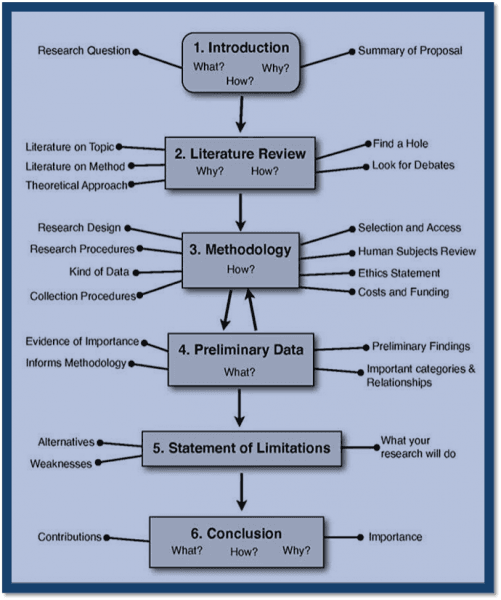Writing a master level proposal is one of the main factor that can help you decide your academic future especially if you want to pursue research degree.Your master thesis or dissertation proposal basically lay the foundation of your future research area you will carry out through thesis or dissertation.The primary objective of your proposal is to get you topic approved in a way you proposed in your paper.Your superviso may ask you to change or modify your proposal before giving you an approval for taking thesis or dissertation.Here we have discussed the General format of the proposal writing and how to write each chapter of your proposal to maximise the chance of getting approval towards future research.
How to Pass your MS/M-Phil thesis?
Your proposal is generally 5 to 10 pages divided into following chapters or parts:
1. Introduction.
The introduction part of your dissertation proposal is the first chapter that undergoes several changes as soon as you progress to the next chapters. This introductory chapter basically set the stage for your complete dissertation proposal journey. This chapter should provide a strong beginning and ground for making your dissertation engaging for your readers. Your dissertation intro part should answer the following questions:
- Why do you want to study this area of the topic, and what do you hope to explore or establish in your research?
- What reader should need to know to understand the topic under discussion?
- what will you cover in each chapter?
- What you are trying to answer? What research gap you found after reviewing of the literature and how your work will fill the gap in the literature?

2. Statement of problem or question.
Writing a strong statement of the problem or research question is crucial for any academic proposal as it sets the foundation for your research. Here’s how you can craft one effectively:
1. Identify the Problem
- Clearly articulate the issue or gap in knowledge you aim to address.
- Frame the problem in terms of significance to the field or societal impact.
Example:
“Despite advancements in AI-driven diagnostic tools, their adoption in low-resource healthcare settings remains limited due to cost and infrastructure barriers.”
2. Contextualize the Problem
- Provide background information to explain the problem’s relevance.
- Show evidence from previous studies, reports, or statistics to justify its importance.
Example:
“Studies indicate that while AI tools reduce diagnostic errors by 30%, their utilization in rural healthcare remains below 10% due to limited resources.”
3. Specify the Gap
- Highlight what existing research has not addressed.
- Make it clear why this gap is worth investigating.
Example:
“Existing research focuses on the technical development of AI diagnostic tools but lacks emphasis on strategies to make these tools accessible in low-resource settings.”
4. Pose a Research Question
- Turn the problem into a clear, concise question your research will answer.
- Ensure it is specific, focused, and researchable.
Example:
“What cost-effective strategies can improve the adoption of AI-driven diagnostic tools in low-resource healthcare settings?”
5. Show the Impact
- State how addressing the problem will contribute to your field or solve practical issues.
Example:
“Addressing this problem will provide actionable insights to policymakers and technologists, potentially improving healthcare outcomes in underserved areas.”
Template for Statement of Problem
- Introduction to the Issue: Begin with a brief overview of the problem.
- Significance: Explain why the problem matters.
- Gap in Research: Highlight what is missing or unresolved.
- Research Question: End with the question(s) your research will answer.
By following this structure, you’ll create a compelling and academically rigorous statement of the problem or research question. Let me know if you’d like a customized example!
3. Literature review:
Keep in mind the following points while writing a Literature review because this will justify the research gaps and problems you will cover in your research.
- Relates the proposed project to specific research questions and areas of inquiry within the field.
- Situates the project within the “conversation” of a field. Who in the field would be interested in reading your thesis?
- Explains how your project will extend, revise, or complicate what is already known.
- For a proposal, the literature review should be relatively brief and should cite/incorporate only the most relevant and recent not older than 5 years must be referenced with sources.
4. Statement of overall purpose.
- Should include a statement that begins “The purpose of this study is…”
- Provides a clear and succinct synopsis of the project.
- Identifies and defines the central concepts of the study.
- Identifies the method of study.
Steps to Write a Statement of Overall Purpose
- Start with a Broad Context:
Introduce the general area of research and explain why it is significant.
Example:
“In recent years, the prevalence of [research topic] has highlighted the need for [specific focus].” - Specify Your Research Focus:
Clearly identify the particular aspect of the topic your study will address.
Example:
“This proposal seeks to explore the impact of [specific aspect] on [target group or phenomenon].” - Define Your Goals:
State what you aim to achieve with your research. This could be new knowledge, solutions to a problem, or a contribution to existing literature.
Example:
“The purpose of this study is to [main objective], contributing to [field or discipline].” - Highlight the Relevance:
Explain why your research is important and how it aligns with academic, social, or practical needs.
Example:
“Understanding [specific issue] is crucial for [broader application or implication], making this study timely and relevant.” - Keep it Concise:
Limit your statement to 3–5 sentences to ensure clarity and focus.
Example Statement of Overall Purpose
“The purpose of this study is to examine the role of social media in shaping public opinion during political campaigns. With the increasing influence of digital platforms, understanding how these mediums affect voter behavior is critical for political scientists and policymakers. This research aims to contribute to the field by analyzing patterns of engagement and identifying strategies for fostering informed public discourse.”
This approach keeps the statement specific, focused, and impactful while addressing the broader significance of the study.
5. Chapter overviews.
- Includes titles, indicate what question you plan to answer and why this particular site is the best one to answer this question.
6. Explanation of limitations.
- What is your project not addressing and why?
- What are some of the weaknesses of your approach to the topic?
7. Statement of the project’s significance.
- What specifically will this project contribute to the field? How will it address the questions or gaps in scholarship that you identified in your literature review? Why is it important to do?
8. Work plan/timeline.
Writing a clear and effective Work Plan/Timeline for an academic proposal involves breaking down your project into manageable phases, assigning timeframes, and outlining specific tasks or milestones. Here’s how to structure it:
1. Start with an Overview
Begin by briefly describing the purpose of the work plan. Highlight its role in outlining the project’s workflow, expected milestones, and timelines. For example:
“This work plan outlines the key tasks, milestones, and timelines for completing the proposed research project on [topic]. It ensures systematic progress toward achieving the project’s objectives.”
2. Divide the Project into Phases
Structure the work plan into key phases, typically aligned with the research process. Common phases include:
- Preparation: Literature review, proposal refinement, and methodology design.
- Data Collection: Conducting surveys, interviews, or experiments.
- Data Analysis: Organizing and analyzing collected data.
- Writing: Drafting and finalizing chapters, articles, or reports.
- Revisions: Reviewing and incorporating feedback.
- Submission/Defense: Preparing for submission or presentation.
3. Use a Timeline
Present tasks in chronological order using a table, Gantt chart, or bullet points. For example:
| Phase | Tasks | Timeline |
|---|---|---|
| Preparation | Conduct literature review, refine proposal | Month 1 – Month 2 |
| Data Collection | Distribute surveys, conduct interviews | Month 3 – Month 4 |
| Data Analysis | Analyze survey results, code qualitative data | Month 5 – Month 6 |
| Writing | Draft chapters: Introduction, Methods | Month 7 – Month 9 |
| Revisions | Review and revise based on feedback | Month 10 |
| Submission/Defense | Finalize thesis and prepare for defense | Month 11 – Month 12 |
4. Be Realistic
Ensure the timeline accounts for:
- Complexity of tasks: Longer phases for more challenging tasks.
- Availability of resources: Access to participants, tools, or data.
- Potential delays: Include buffer time for unforeseen issues.
5. Incorporate Milestones
Highlight significant achievements within each phase, such as:
- Completing the literature review.
- Securing ethical approval.
- Finalizing data collection.
- Submitting the first draft.
6. Visual Representation (Optional)
Use a Gantt chart or timeline diagram for clarity. Tools like Microsoft Excel, Google Sheets, or project management software (e.g., Trello or Asana) can help create visual timelines.
Example Work Plan Description:
“The research will progress over 12 months, divided into six phases: preparation, data collection, analysis, writing, revisions, and submission. Each phase includes specific tasks and milestones, ensuring timely completion of the study. A detailed timeline is provided below to illustrate the project’s workflow and deliverables.”
This approach ensures a professional and structured work plan that demonstrates feasibility and organization in your academic proposal.
9. Bibliography.
A bibliography for an academic proposal lists the sources you have referenced or plan to use during your research. It demonstrates the scope of your research and provides credit to original authors. Here’s how to write a bibliography effectively:
1. Understand the Required Citation Style
Determine the format required by your academic institution or discipline. Common styles include:
- APA (American Psychological Association): Common in social sciences.
- MLA (Modern Language Association): Common in humanities.
- Chicago: Used in a variety of disciplines, including history and business.
- Harvard: Common in the UK and Australian institutions.
2. Gather Necessary Information
Each citation should include:
- Books: Author(s), title, edition, publisher, year of publication.
- Articles: Author(s), article title, journal name, volume, issue, page numbers, year.
- Websites: Author(s), title, URL, date of publication or access.
3. Structure the Entries
Follow the rules of the citation style. Examples for different styles:
APA Format
- Book:
Smith, J. (2020). Understanding Psychology. New York, NY: Academic Press. - Journal Article:
Brown, T., & Green, P. (2019). The role of technology in education. Journal of Educational Research, 45(2), 123-145.
MLA Format
- Book:
Smith, John. Understanding Psychology. Academic Press, 2020. - Journal Article:
Brown, Tom, and Peter Green. “The Role of Technology in Education.” Journal of Educational Research, vol. 45, no. 2, 2019, pp. 123-145.
Chicago Format
- Book:
Smith, John. Understanding Psychology. New York: Academic Press, 2020. - Journal Article:
Brown, Tom, and Peter Green. “The Role of Technology in Education.” Journal of Educational Research 45, no. 2 (2019): 123-145.
Harvard Format
- Book:
Smith, J., 2020. Understanding Psychology. New York: Academic Press. - Journal Article:
Brown, T. and Green, P., 2019. The role of technology in education. Journal of Educational Research, 45(2), pp.123-145.
4. Arrange Alphabetically
Sort entries alphabetically by the last name of the first author.
5. Add the Bibliography to Your Proposal
- Title the section as “Bibliography” or “References”, depending on the style.
- Use consistent formatting throughout.
Example Bibliography in APA Style for an Academic Proposal
Bibliography
- Brown, T., & Green, P. (2019). The role of technology in education. Journal of Educational Research, 45(2), 123-145.
- Smith, J. (2020). Understanding Psychology. New York, NY: Academic Press.
- Taylor, R. (2021). Innovations in research methodology. Social Science Review, 12(4), 200-210.
As a professional academic writer, you can Contact us for Writing a Master’s Proposal for your academic program from Master’s to PhD at a reasonable cost.
